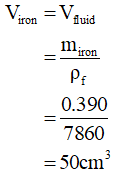p(103 kg/m or g/mL) p(103 kg/m or g/mL) p(103 kg/m or g/mL) Substance Substance Substance Solids Liquids Gases Aluminum 2.7 Water (4°C) 1.000 Air 1.29x 10-3 Carbon Brass 8.44 Blood 1.05 dioxide 1.98x 10-3 Copper (average) Carbon 8.8 Sea water 1.025 1.25x10-3 monoxide Hydrogen Mercury 0.090x10-3 Gold 19.32 13.6 Iron or steel Ethyl alcohol 0.79 Helium 0.18x10-3 7.8 Lead 11.3 Methane 0.72x 10-3 Petrol 0.68 Polystyrene 0.10 Glycerin 1.26 Nitrogen 1.25x10-3 Tungsten 19.30 Olive oil 0.92 Nitrous oxide 1.98x10-3 Uranium 18.70 Oxygen 1.43x 10-3 Steam Concrete 2.30-3.0 (100° C) 0.60x 10-3 Cork 0.24 Glass, common 2.6 (average) Granite 2.7 Earth's crust 3.3 Wood 0.3-0.9 Ice (0°C) 0.917 Bone 1.7-2.0
Fluid Pressure
The term fluid pressure is coined as, the measurement of the force per unit area of a given surface of a closed container. It is a branch of physics that helps to study the properties of fluid under various conditions of force.
Gauge Pressure
Pressure is the physical force acting per unit area on a body; the applied force is perpendicular to the surface of the object per unit area. The air around us at sea level exerts a pressure (atmospheric pressure) of about 14.7 psi but this doesn’t seem to bother anyone as the bodily fluids are constantly pushing outwards with the same force but if one swims down into the ocean a few feet below the surface one can notice the difference, there is increased pressure on the eardrum, this is due to an increase in hydrostatic pressure.
Archimedes’ principle can be used to calculate the density
of a fluid as well as that of a solid. Suppose a chunk of iron
with a mass of 390.0 g in air is found to have an apparent
mass of 350.5 g when completely submerged in an unknown
liquid.
(a) What mass of fluid does the iron displace?
(b) What is the volume of iron, using its density as given shown
(c) Calculate the fluid’s density and identify it.

The buoyant force on the iron is

Now, the mass of fluid displaced can be obtained as

The volume of iron equals the volume displaced. Therefore,

Step by step
Solved in 3 steps with 4 images









